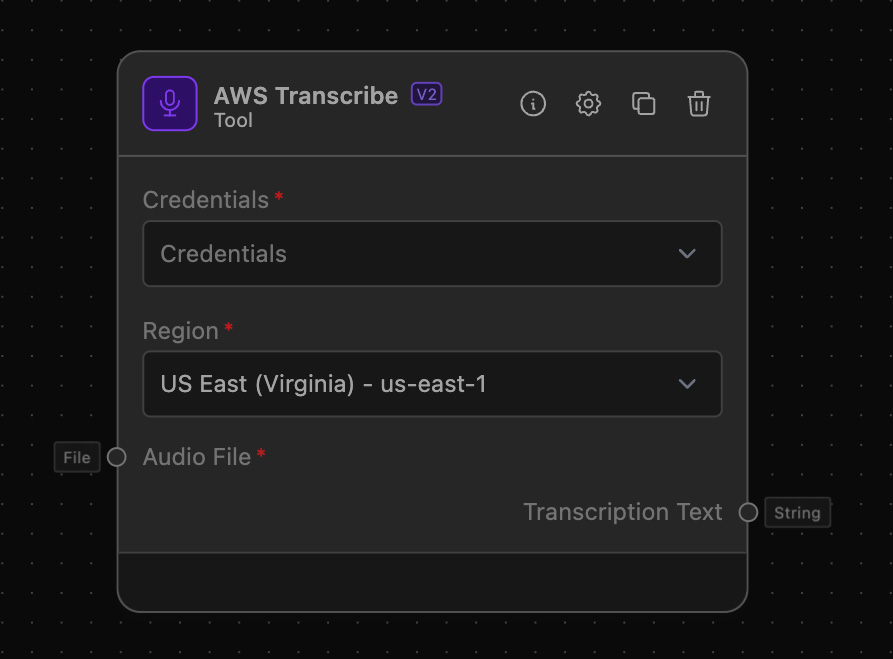AWS Transcribe
Effortlessly convert audio into text
What is AWS Transcribe?

The AWS Transcribe Node utilizes Amazon's AWS Transcribe service to convert audio files into text. This powerful tool supports a range of audio formats and delivers the output as editable text. It is particularly useful for transforming audio recordings like meetings, lectures, or interviews into text form, which can then be searched, archived, or further processed.
How to use AWS Transcribe?
Using AWS Transcribe involves providing an audio file, and executing the workflow to obtain a transcription. Here are detailed steps to guide you through the setup:
-
Provide the Audio File:
- Use a File Input Node: Drag a
File Inputnode onto your canvas. This node can provide a file hosted in an s3 bucket. - Connect Your Audio File: Connect the output anchor of the File Input node to the
Audio Fileinput on the AWS Transcribe node. This connection passes the audio file to the Transcribe node for processing.
- Use a File Input Node: Drag a
-
Execute the Workflow:
- Run the Workflow: After setting up the nodes, execute your workflow by clicking the run button. The transcription process will start, and once completed, the transcribed text will be available at the output anchor of the AWS Transcribe node.
- Use the Transcribed Text: Connect the output anchor to other nodes for further processing or analysis, such as saving the text to a database, performing text analysis, or even feeding it into another AI service for additional insights.
Required AWS IAM Roles and Permissions
Ensure the AWS credentials have the following permissions:
transcribe:StartTranscriptionJobtranscribe:GetTranscriptionJob
These permissions are required to start and retrieve transcription jobs from AWS Transcribe.
Example of Usage
Example Task: Transcribing a Recorded Meeting
To transcribe an audio recording of a meeting:
- File Input Node: Add this node to select your meeting audio file.
- AWS Transcribe Node: It receives the audio file and processes it into text.
- Text Output Node: Use this node to capture and display the transcription output from the AWS Transcribe node.
Integration with OpenAI for Advanced Processing
After transcribing the text, it can be sent to an OpenAI node for further processing, such as:
- Summarization: Generate a concise summary of the transcribed text.
- Translation: Translate the text into another language.
- Sentiment Analysis: Determine the sentiment expressed in the text.
Helpful References
- AWS Transcribe Documentation: Official AWS documentation providing detailed insights into AWS Transcribe capabilities and configurations.
- AWS Security Credentials: This guide helps you understand and manage AWS credentials securely.
Best Practices
- Audio Quality: Higher quality audio yields better transcription accuracy. Ensure your recordings are clear and minimize background noise.
- Supported Languages: Check AWS Transcribe for supported languages to ensure compatibility with your audio content.
- Cost Awareness: Be mindful of AWS Transcribe pricing to manage your usage according to your budget.